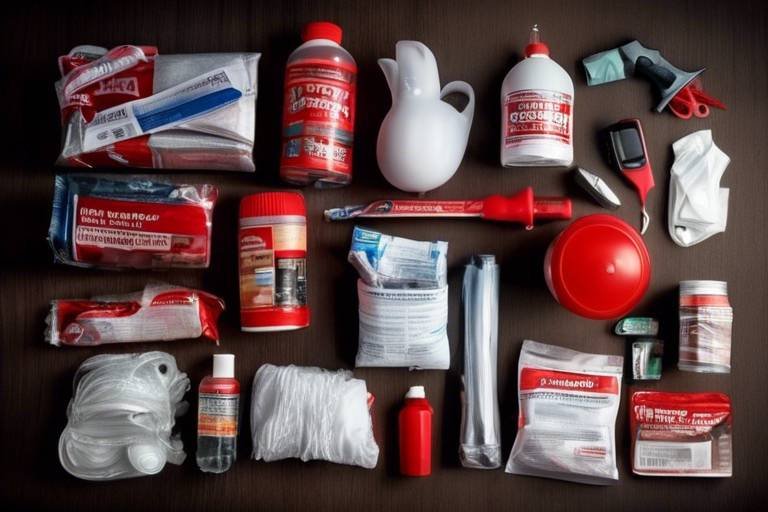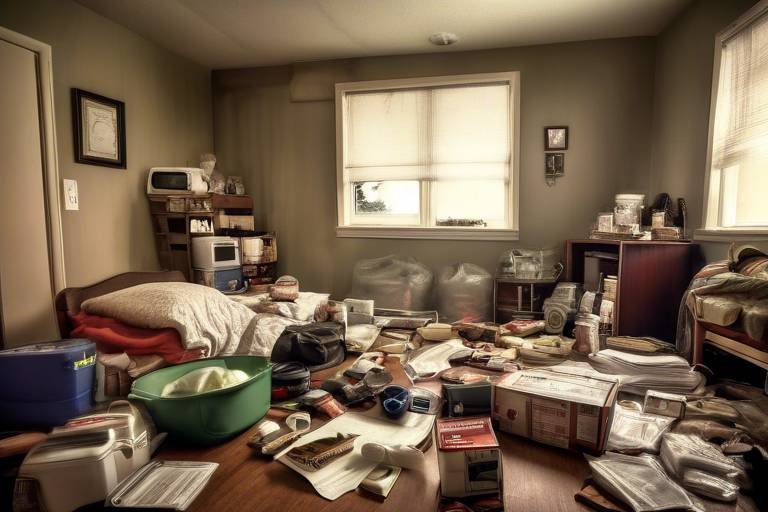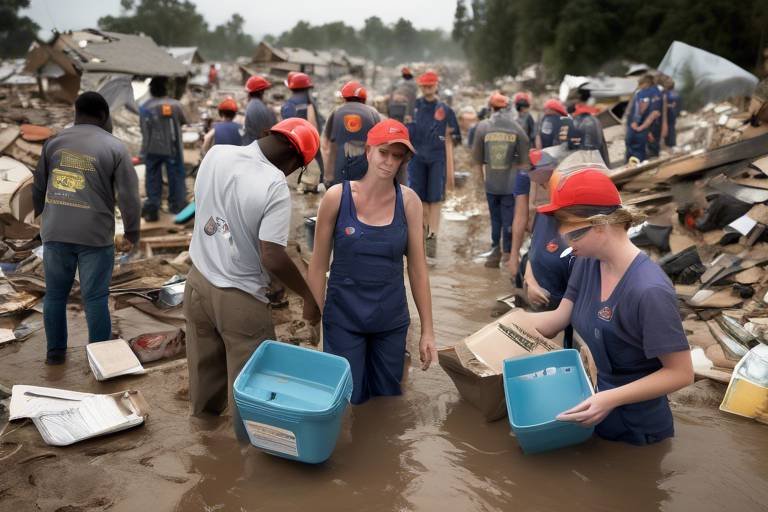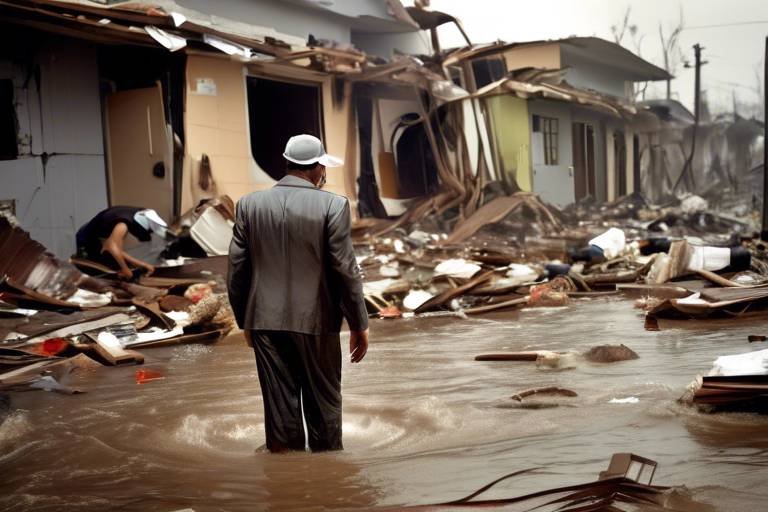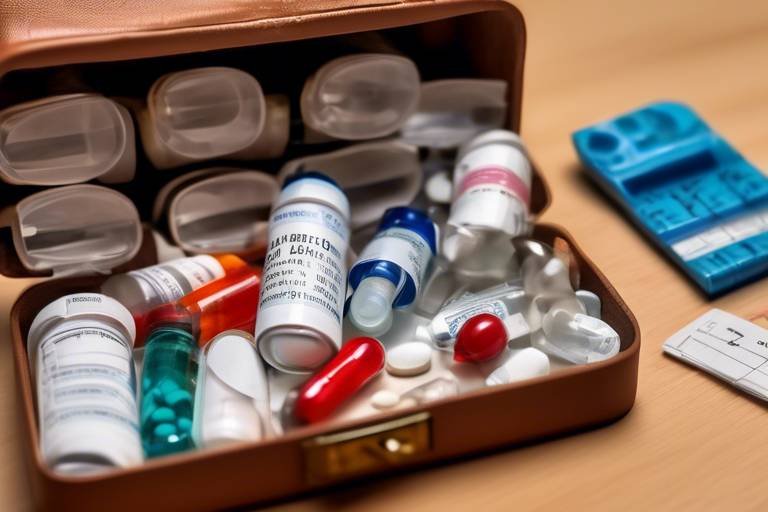Essential Supplies for a Winter Emergency Kit
As winter approaches, the chill in the air serves as a reminder that we need to prepare for those unexpected weather events. A well-stocked winter emergency kit is not just a luxury; it’s a necessity. Imagine being caught in a snowstorm, with no way to stay warm or find help. That scenario can quickly turn from a minor inconvenience to a life-threatening situation. By assembling a comprehensive winter emergency kit, you can ensure your safety and well-being when the weather takes a turn for the worse. So, what exactly should you include in this vital kit? Let’s dive into the essentials!
First and foremost, your kit should contain basic survival gear. This includes items that can provide light, power, and versatility in emergency situations. Think about it: when the lights go out, a reliable flashlight can be your best friend. Make sure to pack extra batteries too, because a flashlight without power is just a fancy stick! Additionally, a multi-tool can be invaluable. It’s like having a toolbox in your pocket, ready to tackle whatever challenges come your way. Here’s a quick breakdown of must-have items:
- Flashlight with extra batteries
- Multi-tool or Swiss Army knife
- Portable phone charger
Next up is the importance of warm clothing and blankets. When the temperature drops, staying warm is crucial to prevent conditions like hypothermia. You never know when you might find yourself stranded or without power, so having insulated blankets and extra layers can make all the difference. It’s like wrapping yourself in a warm hug on a freezing night. Be sure to include items like:
- Insulated jackets
- Blankets or sleeping bags
- Warm hats and gloves
Don’t forget about your feet! Insulated footwear is essential for keeping your toes toasty and dry during snowy conditions. Think of your feet as the foundation of your body; if they’re cold, it’s hard to feel warm anywhere else. Look for boots that offer good insulation and waterproofing to ensure comfort and safety during outdoor emergencies.
Along with insulated boots, thermal socks are a game-changer. They provide that extra layer of warmth and help wick moisture away, keeping your feet dry and cozy even in the coldest conditions. When you’re out in the snow, the last thing you want is wet socks! So, invest in a few pairs of good-quality thermal socks to keep your feet happy.
Understanding layering techniques can significantly enhance your comfort level. Layering allows you to adjust your clothing based on your activity level and the ever-changing winter weather. Start with a moisture-wicking base layer, add an insulating layer, and top it off with a waterproof outer layer. This method is like building a fortress against the cold—each layer adds protection and warmth.
Now, let’s talk about emergency food and water supplies. It’s vital to stock up on non-perishable items that can sustain you during prolonged outages. Think canned goods, energy bars, and dried fruits. These items are not only easy to store but also provide the necessary nutrients to keep your energy up. And don’t forget about hydration! Always keep a supply of water on hand. A good rule of thumb is to have at least one gallon of water per person per day.
A well-stocked first aid kit is crucial for addressing any injuries that may arise during winter emergencies. You never know when a slip on the ice might lead to a scraped knee or worse. Ensure your kit includes bandages, antiseptics, and any personal medications you may need. Quick access to these items can mean the difference between a minor issue and a serious problem.
Speaking of medications, don’t forget to include your necessary medications and health supplies in your kit. If you have specific health needs, make sure to have a sufficient supply of your prescribed medications. It’s like having an insurance policy for your health during emergencies—better safe than sorry!
Lastly, keep a list of emergency contact information readily available. This should include family members, close friends, and local emergency services. In a crisis, being able to quickly reach out for help can be a lifesaver. It’s like having a roadmap to safety; you know where to turn when things get tough.
Don’t forget about your vehicle! Having the right tools for vehicle safety can be a lifesaver if you get stuck in the snow. Jumper cables, shovels, and tire inflators are essential items that can help keep your vehicle operational in winter conditions. Imagine being stranded in a snowbank with a dead battery—those jumper cables could be your ticket to freedom!
A roadside emergency kit can provide critical supplies for unexpected vehicle breakdowns. This kit should include flares, reflective triangles, and basic repair tools. It’s like having a safety net for your car—always ready to catch you if you fall!
Finally, don’t overlook the importance of ice scrapers and snow brushes. These tools are vital for maintaining visibility and safety while driving in winter weather. A clear windshield is your best friend when navigating through snow and ice. So, keep these tools handy and make sure your vehicle is ready for whatever winter throws your way.
Q: How often should I check my winter emergency kit?
A: It’s a good idea to check your kit at least once a year, ideally before the winter season starts. This way, you can replace expired items and ensure everything is in working order.
Q: What should I do if I get stuck in the snow?
A: Stay with your vehicle if possible. Use your emergency supplies to stay warm and signal for help. Running your engine occasionally can provide heat, but ensure that the exhaust pipe is clear of snow to avoid carbon monoxide buildup.
Q: Can I use regular clothing instead of specialized winter gear?
A: While regular clothing can provide some warmth, it’s best to invest in specialized winter gear designed for cold conditions. This gear is typically better at insulating and keeping moisture away from your body.

Basic Survival Gear
When winter storms hit, having the right can be a game changer. You never know when you might find yourself in a situation where you need to rely on these essential items. Flashlights, for instance, are not just for lighting up a dark room; they can illuminate your path when the power goes out or help signal for help if you find yourself in an emergency. Pair that with a good supply of batteries, and you’re set to keep the lights on when the world outside is blanketed in snow.
Another indispensable tool is the multi-tool. Think of it as your Swiss Army knife for winter emergencies! It can serve multiple purposes—from opening cans of food to making minor repairs. Instead of fumbling around for individual tools, having a multi-tool can save you time and effort, which are both crucial during an emergency.
In addition to these tools, consider including a portable phone charger in your kit. In today's world, staying connected can be vital. Whether you need to call for help or simply want to check in with loved ones, a charged phone can make all the difference. Combine this with a first aid kit, and you’re on your way to being well-prepared for whatever winter throws your way.
To give you a clearer picture of what to include in your basic survival gear, here’s a quick table:
| Item | Purpose |
|---|---|
| Flashlight | Provides light during power outages |
| Batteries | Powers your flashlight and other devices |
| Multi-tool | Serves multiple functions (cutting, screwing, etc.) |
| Portable Phone Charger | Keeps your phone charged for communication |
| First Aid Kit | Addresses injuries and health issues |
Remember, the goal of having this gear is not just to survive but to thrive in challenging conditions. The peace of mind that comes from knowing you are prepared can make a world of difference when you're faced with the unpredictable nature of winter weather. So, as you gather your supplies, think about how each item will serve you in your time of need. Will your flashlight illuminate the way? Will your multi-tool help you fix a broken item? Consider these questions as you build your winter emergency kit!

Warm Clothing and Blankets
When winter storms hit, the temperature can plummet, making not just a comfort but a necessity. Imagine being stuck at home during a snowstorm, with the wind howling outside and the power going out. In such situations, having the right gear can mean the difference between feeling cozy or freezing. So, what should you include in your winter emergency kit to stay warm and safe?
First and foremost, insulated clothing plays a pivotal role in preserving body heat. Think of it as your personal barrier against the cold. Layering is key here; wearing multiple layers traps heat effectively. A good rule of thumb is to wear a moisture-wicking base layer, followed by an insulating layer, and topped off with a waterproof and windproof outer layer. This way, you can adjust your clothing based on your activity level and the temperature outside, much like adjusting the thermostat in your home.
Don't forget to include thermal blankets in your kit. These lightweight, compact items can provide significant warmth and are easy to store. They reflect body heat back to you, making them incredibly effective in emergencies. You might even want to consider adding a few mylar emergency blankets, which are designed specifically for survival situations. They can be lifesavers when the temperature drops unexpectedly.
Now, let’s talk about your feet. Keeping them warm and dry is crucial, especially if you have to venture outside. Investing in insulated footwear is a smart move. These boots are designed to keep your feet warm in frigid temperatures and provide traction on slippery surfaces. Imagine trudging through a foot of snow with boots that keep your toes toasty—sounds good, right?
Pair your insulated boots with thermal socks. These are not just any socks; they are specifically designed to wick moisture away from your feet while providing insulation. A wet foot in freezing conditions can lead to frostbite, so having a couple of pairs of high-quality thermal socks can make a world of difference. Plus, they add that extra layer of comfort that can keep your spirits high during a winter emergency.
Understanding layering techniques can significantly enhance your comfort during winter emergencies. You want to create a system that allows for flexibility. For example, if you’re shoveling snow and start to sweat, you can remove a layer to cool down. Conversely, if you’re sitting still for a while, adding a layer can trap heat and keep you warm. Think of it like dressing for a day out in the city—your outfit changes based on the activities you have planned, right?
In conclusion, having the right warm clothing and blankets in your winter emergency kit is not just about comfort; it’s about survival. With insulated clothing, thermal blankets, and proper footwear, you'll be prepared to face whatever winter throws your way. Stay warm, stay safe!
- What should I prioritize in my winter emergency kit?
Focus on warm clothing, blankets, food, water, and first-aid supplies. - How many layers should I wear in winter?
Three layers are ideal: a moisture-wicking base, an insulating middle layer, and a waterproof outer layer. - Can I use regular blankets for warmth?
While regular blankets can provide warmth, thermal or mylar blankets are more efficient for emergency situations. - What type of footwear is best for winter?
Insulated, waterproof boots with good traction are essential for winter conditions.

Insulated Footwear
When it comes to winter emergencies, the importance of cannot be overstated. Imagine trudging through a snowstorm or navigating icy terrain with frozen toes; it’s not just uncomfortable, it can be downright dangerous! Keeping your feet warm and dry is essential for maintaining your overall body temperature and comfort. Insulated boots act as a barrier against the biting cold and wet conditions, allowing you to focus on what really matters—staying safe and getting to where you need to go.
Insulated footwear is designed with specific materials and technologies that trap heat while allowing moisture to escape. This means that even if you step in a puddle of slush or snow, your feet will remain dry and insulated. A good pair of insulated boots will typically feature:
- Waterproofing: Look for boots with waterproof materials like Gore-Tex or rubber to keep the moisture out.
- Insulation: Materials such as Thinsulate or fleece can provide excellent warmth without adding excessive bulk.
- Traction: A solid rubber sole with deep treads will help prevent slips and falls on icy surfaces.
But it’s not just about the boots themselves; the right fit is equally important. A snug fit ensures that your feet don’t slide around inside the boot, which can lead to blisters and discomfort. On the other hand, too tight of a fit can restrict circulation, leading to cold feet. It’s a delicate balance that’s worth considering when preparing for winter emergencies.
Moreover, consider the layering technique for your feet. Just as you would layer your clothing, layering your socks can provide additional warmth. Start with a moisture-wicking base layer sock to keep sweat away from your skin, followed by a thicker wool or thermal sock for insulation. This combination can significantly enhance your comfort during extended periods outdoors.
In summary, investing in high-quality insulated footwear is a no-brainer for anyone looking to stay safe and warm during winter emergencies. Whether you're hiking in the snow, dealing with a power outage, or simply navigating your neighborhood after a heavy snowfall, the right boots can make all the difference. So, before the first snow falls, make sure your feet are well-equipped to handle whatever winter throws your way!
Q: How do I choose the right insulated boots for winter?
A: Look for waterproof materials, proper insulation, and a good fit. Don’t forget to consider the type of winter activities you’ll be doing.
Q: Can I wear regular socks with insulated boots?
A: It’s best to wear moisture-wicking socks as a base layer and then a thicker sock on top for added warmth.
Q: How can I maintain my insulated boots?
A: Clean them regularly, dry them properly after use, and apply waterproofing treatments as needed to prolong their life.

Thermal Socks
When it comes to braving the winter chill, are your best friends. Imagine stepping outside into a frosty wonderland, only to feel that biting cold creeping in through your shoes. It's like a surprise attack on your toes! That's why having a reliable pair of thermal socks is essential for anyone facing the winter months. These socks are specially designed to provide insulation and moisture-wicking properties, ensuring your feet stay warm and dry, no matter how low the temperature drops.
But what makes thermal socks so special? Well, they are typically made from a blend of materials such as wool, polyester, and spandex, which work together to trap heat while allowing sweat to escape. This combination keeps your feet cozy without turning them into a sweaty mess. Think of thermal socks as your personal heater for your feet, wrapping them in a warm embrace that makes even the coldest days feel manageable.
Moreover, wearing the right pair of thermal socks can significantly enhance your comfort during outdoor activities. Whether you’re hiking through a snow-covered trail or simply shoveling the driveway, these socks provide that much-needed cushion and support. They come in various thicknesses, so you can choose the perfect pair depending on your activity level and the severity of the cold. For instance, if you’re planning a long day outdoors, opt for thicker thermal socks that offer more padding and warmth. On the other hand, if you’re just running errands, a lighter pair might do the trick.
Additionally, it's important to consider the fit of your thermal socks. A snug fit is crucial to avoid blisters and discomfort, especially when you're on your feet for extended periods. Make sure to select a size that aligns with your shoe size, and look for features like arch support and reinforced heels to enhance durability and comfort.
To help you understand the different types of thermal socks available, here's a quick comparison:
| Type | Material | Best For |
|---|---|---|
| Wool Thermal Socks | Merino Wool | Cold Weather Activities |
| Synthetic Thermal Socks | Polyester/Spandex | Moisture Management |
| Blended Thermal Socks | Wool & Synthetic | Versatile Use |
In summary, investing in a good pair of thermal socks is not just about keeping your feet warm; it’s about enhancing your overall winter experience. They provide the comfort and protection you need to tackle whatever winter throws your way. So, next time you gear up for the cold, don’t forget to slip on those thermal socks. Your feet will thank you!
- How do I wash thermal socks? It's best to follow the care instructions on the label, but generally, washing them in cold water and air drying is recommended to maintain their insulating properties.
- Can I wear thermal socks with regular shoes? Yes, thermal socks are designed to fit comfortably in regular shoes, but ensure they aren't too thick for a snug fit.
- Are thermal socks suitable for all winter activities? Absolutely! They are versatile enough for skiing, hiking, or simply staying warm at home.

Layering Techniques
When it comes to staying warm during winter emergencies, understanding is absolutely essential. Think of layering like building a cake: each layer serves a specific purpose, and together, they create a deliciously warm and protective barrier against the cold. The goal is to trap heat while allowing moisture to escape, keeping you comfortable and dry. Let’s break down the basics.
The first layer, known as the base layer, is all about moisture management. This layer should be snug against your skin and made from materials like merino wool or synthetic fibers, which wick sweat away from your body. Imagine wearing a second skin that keeps you dry while also providing warmth. Avoid cotton at all costs, as it retains moisture and can leave you feeling cold and clammy.
Next up is the insulating layer, which is where the magic happens. This layer traps body heat and provides warmth. Fleece jackets or down vests are excellent choices here. Think of it as a cozy blanket that you can wear! Depending on the temperature, you might want to add or remove this layer to maintain comfort without overheating.
Finally, the outer layer serves as your shield against the elements. This layer should be windproof and waterproof to protect you from snow, rain, and biting winds. Look for jackets with breathable membranes like Gore-Tex, which keep moisture out while allowing sweat to escape. You want to feel like you’re in a protective bubble that keeps the harsh weather at bay.
Now, let’s talk about the importance of adjustability. Weather can be unpredictable, and your activity level can change quickly. By layering, you can easily add or remove clothing to adapt to your needs. For instance, if you’re hiking and start to feel too warm, you can shed an insulating layer without having to strip down completely. This flexibility is crucial for maintaining comfort and preventing overheating or chill.
To summarize, here’s a quick recap of the layering technique:
- Base Layer: Moisture-wicking material close to the skin.
- Insulating Layer: Provides warmth, such as fleece or down.
- Outer Layer: Protects against wind and water, keeping you dry.
By mastering these layering techniques, you’ll be well-equipped to handle whatever winter throws your way. Remember, the key is to stay dry, warm, and comfortable, making your winter adventures not only bearable but enjoyable!
Q: How many layers should I wear during a winter emergency?
A: It typically depends on the weather conditions, but a good rule of thumb is to wear at least three layers: a base layer, an insulating layer, and an outer layer.
Q: Can I use cotton as a base layer?
A: It's best to avoid cotton for your base layer, as it retains moisture. Opt for materials like wool or synthetic fabrics instead.
Q: What should I do if I start to feel too warm?
A: If you feel too warm, it's important to remove an insulating layer to prevent overheating and sweating, which can lead to chills.

Emergency Food and Water Supplies
When the winter winds howl and the snow begins to pile up, having a reliable supply of food and water can be a game changer. Imagine being snowed in, with no power and the temperature dropping—your survival could depend on the items you have on hand. That's why stocking up on emergency food and water supplies is not just a good idea; it's essential for your safety and well-being during winter emergencies.
First and foremost, it's crucial to choose non-perishable food items that can withstand the test of time. Think canned goods, dried fruits, nuts, and energy bars. These items have long shelf lives and can provide the necessary calories and nutrients you need to stay energized. For instance, canned vegetables and beans are not only nutritious but also versatile. You can whip up a quick stew or mix them into your meals for added flavor and sustenance.
When it comes to water, the general rule of thumb is to store at least one gallon of water per person per day for at least three days. This ensures that you have enough for drinking, cooking, and even hygiene purposes. It's wise to keep bottled water in a cool, dark place to avoid any chemical leaching from the plastic. You might also consider investing in a water purification system or water purification tablets, which can be lifesavers if you find yourself in a situation where your water supply gets contaminated.
Here's a quick breakdown of some essential items to consider for your emergency food and water supplies:
| Food Item | Benefits | Shelf Life |
|---|---|---|
| Canned Vegetables | Nutritious, versatile | 2-5 years |
| Dried Fruits | High in energy, easy to store | 1-2 years |
| Energy Bars | Convenient, packed with calories | 6 months - 1 year |
| Peanut Butter | High in protein, filling | 1-2 years |
Don't forget to rotate your supplies regularly! Just like any good plan, your emergency kit should be periodically checked and updated to ensure that nothing is expired or spoiled. This not only keeps your supplies fresh but also gives you peace of mind knowing that you’re prepared for whatever Mother Nature throws your way.
In summary, having a well-thought-out stock of emergency food and water supplies can make all the difference in a winter crisis. So, take a moment to assess your current supplies, make a list of what you need, and get to work on building your winter emergency kit. After all, being prepared is the best way to stay safe and sound when the snow starts to fall.
- How much food should I store for an emergency? Aim for at least a three-day supply of food for each person in your household.
- What types of food are best for emergencies? Non-perishable items like canned goods, dried fruits, nuts, and energy bars are ideal.
- How do I store water safely? Use clean, food-grade containers and store them in a cool, dark place.
- How often should I check my emergency supplies? It's a good idea to check your supplies every six months to ensure everything is fresh.

First Aid Kit Essentials
When winter storms strike, having a well-stocked first aid kit can be a game-changer. Imagine being stuck at home during a snowstorm, and someone in your family gets a cut or a scrape. Instead of panicking, you can reach for your first aid kit and handle the situation with ease. A comprehensive kit should include a variety of items that cater to different injuries and health concerns. These essentials not only help in treating minor injuries but also provide peace of mind during emergencies.
First and foremost, it’s crucial to include bandages in various sizes. From small cuts to larger wounds, having an assortment means you’re prepared for anything. You should also stock up on antiseptic wipes or spray to clean wounds effectively, preventing infections that could complicate an already stressful situation. Additionally, gauze pads and medical tape are vital for larger injuries that need more attention. You might think, “Why do I need all this?” Well, it’s better to have it and not need it than to need it and not have it!
Another essential component of your first aid kit is pain relief medication. Over-the-counter options like ibuprofen or acetaminophen can be lifesavers during a winter emergency, especially if someone is dealing with headaches or body aches due to the cold. It’s also wise to include any prescription medications that you or your family members may need. This way, you’re covered for any potential health issues that could arise during a winter storm.
In addition to these basics, consider adding a few more specialized items to your kit. For instance, a pair of scissors can be invaluable for cutting tape, gauze, or even clothing in an emergency. A digital thermometer is another useful tool, as it can help monitor fevers, especially if someone is feeling unwell. And don’t forget about latex gloves! They are essential for keeping things sanitary while treating wounds.
To ensure that your first aid kit is truly effective, it’s important to periodically check the contents. Items can expire, especially medications, so make it a habit to review your kit every few months. Replace any expired items and restock anything that you’ve used. You might even consider creating a checklist of your first aid kit essentials, so you can easily track what you have and what you need.
Lastly, don’t underestimate the importance of emergency contact information in your first aid kit. This can include numbers for family members, local emergency services, and any important medical information for family members, such as allergies or chronic conditions. In a crisis, having this information at your fingertips can make all the difference.
- What should I include in my first aid kit? A good first aid kit should include bandages, antiseptic wipes, gauze pads, pain relief medications, scissors, a thermometer, and gloves.
- How often should I check my first aid kit? It’s recommended to check your first aid kit every few months to replace expired items and restock any used supplies.
- Can I use my first aid kit for pets? Yes, but ensure to have specific supplies for pets, such as pet-safe antiseptics and bandages.

Medication and Health Supplies
When preparing your winter emergency kit, one of the most critical components you cannot overlook is . Imagine being caught in a snowstorm, stranded at home, or stuck in your vehicle, and needing your essential medications. It’s a scenario that can quickly escalate from inconvenient to dangerous if you're not prepared. Therefore, it’s vital to include a comprehensive selection of health supplies tailored to your specific needs.
Start by gathering any prescription medications you rely on daily. This includes not only your primary medications but also any over-the-counter drugs that can help alleviate common winter ailments, such as colds and flu. Consider packing items like:
- Pain relievers (like ibuprofen or acetaminophen)
- Cold and flu medications
- Allergy medications
- Digestive aids, such as antacids or laxatives
Furthermore, don’t forget to include a basic first aid kit. This should contain band-aids, antiseptic wipes, and gauze, among other essentials. A well-stocked first aid kit can make a world of difference in treating minor injuries that might occur while you’re navigating through winter conditions. You might think, “I can just run to the store if I need something,” but in a winter emergency, that might not be an option. Having these supplies on hand can provide peace of mind and ensure you’re ready for anything.
In addition to medications, consider adding health supplies that might be specific to your family’s needs. For instance, if you have children or elderly family members, you may want to include:
- Thermometers
- Children's medications
- Vitamins and supplements
- Any special medical devices, like inhalers or EpiPens
Lastly, it’s essential to keep your medications in a cool, dry place within your emergency kit. This ensures their efficacy, especially in extreme temperatures that winter can bring. Regularly check the expiration dates and replace any expired items to maintain a fully functional kit. By taking these steps, you not only safeguard your health but also enhance your overall preparedness for winter emergencies.
Q: How often should I check my winter emergency kit?
A: It’s a good practice to check your kit at least twice a year, ideally before the winter season starts. This will help ensure that all items are in good condition and that medications are not expired.
Q: What should I do if I have specific health needs?
A: Tailor your emergency kit to your health requirements. If you have specific medications or devices, make sure to include them in your kit. Consult with your healthcare provider for any additional recommendations.
Q: Can I use a regular backpack for my winter emergency kit?
A: Yes, a regular backpack can be used, but ensure it’s durable and weather-resistant. You want to protect your supplies from moisture and damage.

Emergency Contact Information
When it comes to winter emergencies, having a reliable way to communicate is as crucial as having food or warm clothing. Imagine being stuck in a snowstorm, your car breaks down, and you can't reach anyone for help. That's where a well-organized list of emergency contacts becomes your lifeline. You should compile a list that includes family members, close friends, and emergency services. Make sure this list is easily accessible—whether it's in your wallet, on your phone, or even printed and kept in your emergency kit.
Consider the following categories when creating your emergency contact list:
- Family Members: Include immediate family and any relatives who may live nearby.
- Friends: List friends who are reliable and can assist if things go south.
- Emergency Services: Have the numbers for local police, fire departments, and hospitals.
- Utility Companies: In case of power outages, keep contact information for your local utility providers.
In addition to these contacts, it's wise to include any relevant medical information that could be crucial in an emergency. For example, if you or a family member has specific health conditions or allergies, noting those down can help emergency responders provide the best care possible.
Furthermore, consider using a smartphone app that can store your emergency contacts and medical information securely. Many apps allow you to share this information easily with others, ensuring that during a crisis, you can get the help you need without delay. Remember, the key to survival in any emergency is preparation. So, take a moment to gather your contacts and keep them updated regularly!
Q: What should I include in my emergency contact list?
A: Your emergency contact list should include family members, close friends, local emergency services, and utility companies. Make sure to add any relevant medical information as well.
Q: How should I store my emergency contact information?
A: You can store your emergency contacts in your smartphone, have a printed copy in your emergency kit, or keep them in your wallet for easy access.
Q: Why is it important to have emergency contact information readily available?
A: Having emergency contact information readily available allows for quick communication during a crisis, ensuring that help can be summoned without delay.

Tools for Vehicle Safety
When winter hits, the roads can become treacherous, and having the right can make all the difference between a smooth journey and a stressful situation. Imagine driving through a snowstorm, only to find yourself stuck on the side of the road. The last thing you want is to be unprepared! That’s why having a well-equipped vehicle is essential for anyone who lives in or travels through areas prone to winter weather.
First and foremost, jumper cables are a must-have in your vehicle. Cold weather can be tough on batteries, and a dead battery can leave you stranded. With jumper cables, you can quickly connect to another vehicle and get back on the road without waiting for roadside assistance. It's like having a lifeline when your car decides to take a nap!
Next up, a sturdy shovel is invaluable for digging your car out of snowdrifts or clearing a path to safety. A compact, collapsible shovel can easily fit in your trunk and can be a game-changer when you find yourself stuck. It’s like having your own personal snow removal crew on standby.
Another essential tool is a tire inflator. Winter can wreak havoc on tire pressure, and driving on under-inflated tires is dangerous. A portable tire inflator allows you to quickly pump up your tires whenever needed, ensuring that you maintain optimal traction on slippery roads. Think of it as a quick pit stop that keeps you racing ahead!
In addition to these tools, consider adding a roadside emergency kit to your vehicle. This kit can include items like flares, reflective triangles, and basic repair tools. Here’s a quick overview of what to include in your kit:
| Item | Purpose |
|---|---|
| Flares | To alert other drivers of your presence. |
| Reflective Triangles | To increase visibility and safety when stopped on the roadside. |
| Basic Repair Tools | For quick fixes in case of minor vehicle issues. |
| First Aid Kit | To address any injuries until help arrives. |
Lastly, don’t forget about ice scrapers and snow brushes. These tools are vital for maintaining visibility while driving in winter conditions. Before hitting the road, take a few minutes to clear your windshield, mirrors, and lights of any ice or snow. It’s a simple step that can significantly enhance your safety and that of others on the road.
In conclusion, being prepared with the right tools for vehicle safety can turn a potentially dangerous winter situation into a manageable one. Whether it’s jumper cables, a shovel, or a comprehensive roadside emergency kit, having these items at your disposal ensures that you can tackle whatever winter throws your way. So, as you prepare for the colder months, take a moment to check your vehicle and equip it with the essentials that will keep you safe and sound!
Q: What should I keep in my vehicle for winter emergencies?
A: Essential items include jumper cables, a shovel, tire inflator, ice scraper, snow brush, and a roadside emergency kit.
Q: How can I prevent my battery from dying in cold weather?
A: Regularly check your battery’s health, keep jumper cables in your car, and park in a garage if possible during extreme cold.
Q: What is the best way to stay safe while driving in winter?
A: Always clear your vehicle of snow and ice before driving, maintain a safe distance from other vehicles, and ensure your tires are properly inflated.

Roadside Emergency Kit
When winter weather strikes, the last thing you want is to be caught unprepared on the road. That's why having a is not just a good idea; it's essential for your safety and peace of mind. Imagine being stuck in a snowstorm, your car immobilized, and you have nothing to rely on but the elements. A well-stocked roadside emergency kit can be your lifeline in such situations, providing you with the necessary tools and supplies to stay safe until help arrives.
So, what exactly should you include in your roadside emergency kit? Here’s a breakdown of some critical items that can make a world of difference when you find yourself in a bind:
- Jumper Cables: These are vital for jump-starting your vehicle if the battery dies. You never know when you might need a boost!
- Shovel: A compact shovel can help you dig your car out of snowdrifts, allowing you to get back on the road quickly.
- Flare or Reflective Triangles: These items are crucial for signaling your presence to other drivers, especially during low visibility conditions.
- Basic Repair Tools: A simple toolkit can help you fix minor issues like a flat tire or a loose connection.
- First Aid Kit: In case of minor injuries, having a first aid kit on hand ensures you can treat wounds or manage medical issues until professional help arrives.
Besides these essentials, consider adding a few comfort items to your kit. A blanket can provide warmth, while non-perishable snacks and bottled water can help keep your energy levels up if you’re stuck for an extended period. It’s also wise to include a flashlight with extra batteries, as visibility can quickly diminish in winter storms.
Now, let’s talk about organization. It’s not enough to just toss everything into your trunk. Invest in a durable, waterproof bag to keep your supplies organized and easily accessible. Label your items if necessary, so you can find what you need without fumbling around in the cold.
In summary, a roadside emergency kit is your best friend during winter travels. It’s not just about survival; it’s about ensuring that you can handle whatever the weather throws your way. So, take the time to prepare your kit today, and drive with confidence knowing you’re ready for anything!
1. How often should I check my roadside emergency kit?
It’s a good practice to check your kit at least once every season. This ensures that all items are in working order and that perishables, like snacks and water, are not expired.
2. What should I do if I get stranded in a winter storm?
Stay with your vehicle, as it's often easier for rescuers to find a car than a person in the snow. Keep your engine running intermittently for heat, and make sure your exhaust pipe is clear of snow to prevent carbon monoxide buildup.
3. Can I create my own roadside emergency kit?
Absolutely! You can customize your kit based on your specific needs and the climate in your area. Just make sure to include the essential items mentioned above.

Ice Scrapers and Snow Brushes
When winter arrives, the beauty of snow-covered landscapes can quickly turn into a nightmare for drivers. One moment you're admiring the picturesque scene outside your window, and the next, you're faced with the daunting task of clearing your vehicle before hitting the road. That's where ice scrapers and snow brushes come into play. These essential tools are not just accessories; they are your first line of defense against the icy grip of winter. Imagine trying to navigate a snow-covered road without being able to see through your windshield—it's like trying to read a book with the pages glued shut!
Ice scrapers are designed specifically to tackle the stubborn layer of ice that can accumulate on your windshield and windows. They come in various shapes and sizes, with some featuring a sturdy handle for better grip and leverage. A good ice scraper should have a sharp edge that can easily slice through ice without scratching the glass. On the other hand, snow brushes are perfect for sweeping away the fluffy snow that can pile up on your car's roof, hood, and windows. If left unattended, this snow can slide down while driving, obstructing your view or even causing accidents.
Think about it: how many times have you seen a car driving down the road with a mountain of snow on top? It’s not just a hazard for the driver but also for those around them. To avoid such situations, it’s crucial to invest in quality ice scrapers and snow brushes. Here’s a handy table comparing different types of ice scrapers and snow brushes:
| Tool Type | Best For | Features |
|---|---|---|
| Plastic Ice Scraper | Light ice removal | Lightweight, affordable, easy to store |
| Metal Ice Scraper | Heavy ice removal | Durable, effective but may scratch glass |
| Snow Brush | Snow accumulation | Long handle, soft bristles to prevent scratches |
| Heated Ice Scraper | Quick ice removal | Electric, melts ice for easy scraping |
When choosing the right tools for your winter emergency kit, consider the climate you live in and how much snow or ice you typically encounter. A combination of both an ice scraper and a snow brush is often the best approach, ensuring you’re fully prepared for whatever winter throws your way. And don’t forget to keep them easily accessible in your vehicle; after all, the last thing you want is to dig through your trunk in a snowstorm!
- How often should I use my ice scraper and snow brush? It's best to use them every time you need to clear your vehicle before driving, especially after a snowfall or ice storm.
- Can I use a regular household item instead of an ice scraper? While some people use items like credit cards, it's not recommended as they can scratch your windshield. It's best to use a proper ice scraper.
- What should I look for when buying an ice scraper or snow brush? Look for durability, comfort, and the right size for your vehicle. A good grip and a sturdy handle can make a significant difference.
Frequently Asked Questions
- What are the essential items to include in a winter emergency kit?
When preparing your winter emergency kit, make sure to include items like flashlights, batteries, multi-tools, warm clothing, blankets, non-perishable food, water, a first aid kit, and necessary medications. These supplies will help you stay safe and comfortable during unexpected winter weather.
- How can I keep warm during a winter emergency?
To maintain warmth, layer your clothing effectively. Start with thermal socks and insulated footwear to keep your feet warm. Use blankets and sleeping bags to trap heat, and consider using hand and foot warmers if available. Staying dry is crucial, so avoid wet clothing and footwear.
- What should I include in a first aid kit for winter emergencies?
Your first aid kit should contain bandages, antiseptic wipes, gauze, adhesive tape, scissors, and any specific medications you may need. Don't forget to include a first aid manual or instructions, as they can be invaluable during emergencies.
- How can I ensure my vehicle is prepared for winter conditions?
To prepare your vehicle, keep a roadside emergency kit that includes jumper cables, flares, a shovel, and tire inflators. Regularly check your tires for proper inflation and tread depth, and ensure your battery is in good condition. It's also wise to have a full tank of gas to avoid running out in cold weather.
- What food and water supplies should I stock for an emergency?
Opt for non-perishable food items like canned goods, energy bars, and dried fruits. For water, aim for at least one gallon per person per day, and store enough to last for several days. Remember to rotate your supplies regularly to keep them fresh!
- How can I find emergency contact information quickly?
Keep a list of emergency contacts in your winter emergency kit, and consider saving them in your phone. You might also want to write down important numbers on a piece of paper and store it in a waterproof bag, so it's accessible even if your phone is out of battery.

